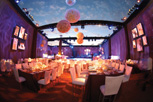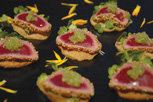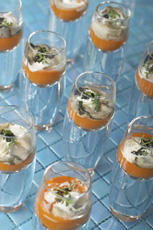


By Kirsten Bourne
Fortunately for catering companies, people continue to get married, celebrate the holiday season and fundraise for charities, no matter the economic climate. Like the many restaurants that have gotten creative to combat the number of customers opting to dine out less frequently, the catering world has rolled with the punches of today’s trying economic atmosphere. Leading caterers in the San Francisco, San Diego and Las Vegas areas are proof that by focusing on what clients are now looking for, it is possible to maintain a thriving business. Their thoughts on environmental consciousness, menu selection and presentation style may be a wise lesson to the less transient service format of restaurant dining.
Focusing on environmental stewardship
Traditionally, the client’s number one criterion for deciding on a caterer has been their menu. Today, however, many customers have a new top priority: environmental stewardship. Jane Hammond, owner of Jane Hammond Events in Berkeley, Calif., knows that clients select her for her commitment to all things green. Every piece of servingware is compostable, made of corn starch, sugar cane bark or other plant materials. Biobags line the trash cans and waste is composted on the event site. A line item for carbon offsets, payments to reverse the environmental damage caused by driving food to the event, is added to the bottom of every bill; clients may select not to pay the offset but almost none do. Hammond has even begun to curtail the use of cut flowers, opting instead for plants that can be reused for months on end. “Everything has repercussions,” says Hammond, “and clients are paying attention to that.”
Carrie Sullivan, head of catering at community leader Bi-Rite Market in San Francisco, has noticed that while she used to be the one educating customers about the use of non-disposable materials, it’s now her clients who are leading the discussion in this area. “Even companies that don’t really focus on being green care about their image….I am being contacted by the ‘sustainability associate’ of a client’s organization, as opposed to their event planner.”
The client who has an eye on sustainability will equally focus on the seasonality of their menu. “I used to cook seasonally for selfish reasons,” remembers Andrew Spurgin, Executive Director and Chef of Waters Fine Catering in San Diego, “but now people are coming to me for that.” Hammond agrees: “Someone might now take my advice not to serve asparagus in the fall.” Allowing the seasons to dictate menu planning may be more challenging for a restaurant than it is for a catering outfit, as restaurants must plan their menu months in advance of knowing what a given year’s harvest will bring; therefore, Spurgin recommends keeping detailed records, year after year: identifying when local and seasonal fruits and vegetables come into season as a way to predict timing and availability for future seasons.
Sustainability trumps style
Along with clients’ attention to environmental costs comes scrutiny of financial ones. “The surf and turf is no longer necessarily lobster and filet mignon,” says Eva Paulussen, CEO of Wild Truffles Catering in Las Vegas, who might instead try a duo of pork and scallops.
“It’s all about indulging the ingredients,” agrees Spurgin, who has noticed that he is writing menus more like he cooks at home; “Roast Chicken can be the star of a menu.” Sullivan’s customers come to Bi-Rite for “substance over style.” They’re not looking for fancy food towers or foams; instead they’re insistent upon the catchphrases – local, fresh, sustainable – that must dictate the ingredients.
Jane Hammond agrees that because of the economy, “Even those with the means don’t want to serve caviar.” Instead of extravagance, the quality of the ingredients is paramount to her clients: “Good bread and good coffee have been around for years….now my clients are looking for the best salts on the planet, whether Australian Murray River or Himalayan pink.”
Broadening client’s culinary choices
For Spurgin, the joy of catering is in educating diners about new foods and making them more accessible. He sites craft beers as a trend that has emerged in Southern California and an opportunity for dialogue about the nuances of flavor and artisanal brewing methods among people who may not be accustomed to such discussion. “We have the opportunity to educate people – to raise the bar.” Spurgin laughs as he recalls shocking a party of mostly European guests with the quality of a cheese course comprised solely of cheeses of American origin. One advantage caterers have over the typical restaurateur is their ability to quickly react to happenings in the community and incorporate relevant themes into their menus. MeMe Pederson of Taste Catering in San Francisco sites the arrival of the King Tut exhibit to the city as an opportunity to serve Egyptian food.
Just as new technology and social networking forums in recent years have caused people to be less committal to a single job or relationship, guests at catered events are less willing to commit to sitting in one place while they eat, or choosing a single dish. People have developed what Vogue food critic Jeffrey Steingarten has coined “cafeteria diets,” preferring to sample many flavors over eating a large portion of the same thing.
Small plates and tall tables bring guests together
Caterers have been quick to adapt to the tendency of partygoers to gravitate towards a tapas-style, small bites format for foodservice. Paulussen has noticed that although “some people are stuck on the buffet and they’ll never change,” most people want a reception-style party, meaning passed apps and tasting stations. Spurgin likes to set up a C-shaped “tasting bar,” with staff manning the cooking station in the middle and guests circling around the outside.
Tall tables that allow guests to perch while standing are another format that encourages mingling and tasting, and look even nicer when interspersed with regular seat-level tables. These standing tables have popped up at restaurants across the country – Mario Batali at his NY pizzeria Otto, for example – with the successful effect of creating a casual and familial lounge vibe as a precursor to a seated meal.
Although it may look, from the shot glass of soup or one-bite serving of ice cream, like the recession has really hit, these bite-size delivery formats are actually a sign of caterers opening their ears to the desires of the modern day sophisticated client. Look closer at the apple parsnip soup with curry oil and the spoonful of pea and mint gelato with arugula and sea salt, and you will see that times are not as tough they seem.
Kirsten Bourne is a food retail entrepreneur based in San Francisco who spends her Saturdays slinging smoked salmon sandwiches at the Ferry Building. She holds a BA in International Relations from Stanford University and her freelance writing has appeared in New York-based City Magazine among others. Check out her food blog at www.kikoscafename.blogspot.com.



